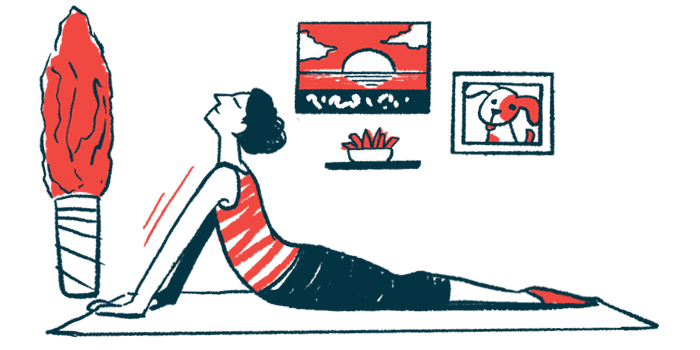Exercise, especially mind-body, eases motor symptoms
Analysis of physiotherapy trials to spot forms that might most help patients
Written by |

Physiotherapy, and mind-body exercise particularly, can meaningfully ease motor symptoms of Parkinson’s disease, a recent meta-analysis of clinical trial data involving more than 2,500 people reported.
Mind-body exercise refers to practices that focus on the connection between the body, breath, and the mind, such as yoga, tai chi, or dance. This type of exercise therapy led to significant gains across most measures of Parkinson’s motor symptoms, with beneficial changes in areas that also included patients’ gait, balance, and mobility.
Clinical improvements also were seen in trials of physical exercise like strength training and aerobic exercise, as well as in those using noninvasive brain stimulation.
Studies involving acupuncture were least likely to lead to motor gains, possibly because most its trials focus on nonmotor Parkinson’s symptoms.
“The results showed that mind-body exercise had a good improvement in all four aspects of motor symptom severity, balance, gait, and functional mobility, and was the best of the six exercise interventions” evaluated, the researchers in China wrote. But further study to validate these findings and to compare various approaches are needed, they added.
The study, “Effect of Physiotherapy Interventions on Motor Symptoms in People With Parkinson’s Disease: A Systematic Review and Meta-Analysis,” was published in Biological Research for Nursing.
Physiotherapy given to restore or improve motor skills and movement
Physiotherapy is a term covering a range of noninvasive interventions aimed at restoring or improving a person’s movement and motor abilities. It encompasses physical exercise, in addition to approaches such as noninvasive brain stimulation (NiBS) or acupuncture that are thought to positively alter nerve cell function.
NiBS uses magnets or electrical currents, placed on the skull, to modulate nerve cell activity in the brain, whereas acupuncture involves placing thin needles on select areas of the body to stimulate nerve cells.
A growing body of evidence indicates that physiotherapy may be of significant benefit for Parkinson’s patients, leading to gains in motor function while easing other disease symptoms.
In particular, physical exercise is thought to be a low-cost and highly effective option, and some studies also suggest that NiBS or acupuncture can help patients.
But with many types of physiotherapy becoming available, a need for “evidence” into those with a potential for the greatest benefits in Parkinson’s “motor disorders” also is growing, the scientists, led by those at Peking University in Beijing, wrote.
The researchers conducted a systematic review of published data from randomized and controlled clinical trials related to physiotherapy in Parkinson’s. Their goal was to determine how each of six types of this therapy affected motor symptom severity, as assessed by the Movement Disorder Society – Unified Parkinson’s Disease Rating Scale (MDS-UPDRS) Part III, which focuses on motor abilities.
Ultimately, 42 trials involving 2,530 people were included in their analysis. Evaluated therapy forms were strength or resistance training (10 studies), balance/gait training (seven studies), mind-body exercise (13 studies), aerobic exercise (five studies), NiBS (six studies), and acupuncture (three studies).
In general, trial participants were assigned to a particular physiotherapy approach or to a control group, typically being given standard care without physiotherapy.
Across 31 studies involving 1,712 people, MDS-UPDRS Part III scores fell significantly for patients given physiotherapy relative to controls, signifying gains in motor function. With an average of a 3.41 point drop in MDS-UPDRS Part III scores, it reached the threshold considered clinically meaningful, which is defined as a greater than 2.5-point reduction.
Strength training, mind-body exercise, aerobic exercise, and NiBS were associated with this lessening in motor symptom severity, whereas balance/gait training and acupuncture were not.
Significant gains in MDS-UPDRS scores with mind-body exercise, NiBS
Gains seen with mind-body exercise and NiBS were considered statistically significant and clinically meaningful. In trials of these two approaches, drops in MDS-UPDRS Part III scores were on average 5.36 points for mind-body exercise and 4.59 points for NiBS.
“The effectiveness of mind-body exercise on motor symptoms in PD [Parkinson’s disease] has been recognized in many studies … as it enhances awareness and improves mind-body coordination through concentration and a sequence of various controlled movement exercises,” the scientists wrote. NiBS, “an emerging and safe form of physical therapy … is thought to modulate brain plasticity” to improve motor abilities.
Physiotherapy in general also was also associated with improvements in balance, walking speed, endurance, and functional mobility, with varying effects for individual therapy types.
In general, mind-body exercise led most often to positive changes and significant improvements in all four evaluated domains: motor symptoms, balance, gait, and functional mobility.
“Our findings showed that mind-body exercise and NiBS appear to be superior to strength training and aerobic exercise in improving the severity of motor symptoms,” the scientists wrote.
Still, the effects of strength training or aerobic exercise were stronger than those of mind-body exercise in certain domains — namely, balance, functional mobility, and endurance. Balance/gait training, likewise, “was very effective in improving balance and functional mobility,” though significance was not seen with motor symptoms, they added.
Acupuncture, with only three studies including required measures of motor symptom changes, is in need of high-quality controlled trials.
“In order to provide participants with the greatest motor function benefit, it is necessary to further explore in the future whether the effect of combined exercise exceeds that of using [one form] alone,” the researchers wrote, also noting a need to directly compare these forms of therapy.
While these findings, overall, suggest that mind-body exercise “is most worthy of being promoted” and “the best choice for physiotherapists,” the researchers noted that a patient’s preferences will determine which approach they are most likely to adhere to.






